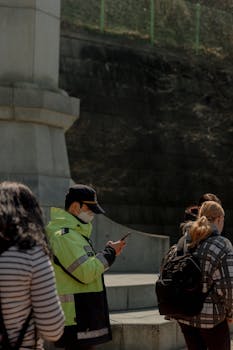Outdoor marketing encompasses various strategies designed to promote products and services in outdoor spaces. It includes billboards, transit advertising, and event sponsorships, creating unique ways to engage with potential customers. This article explores outdoor marketing’s effectiveness, benefits, and various strategies, providing insights for businesses aiming to harness its power.
Understanding outdoor marketing is essential in modern advertising, especially as consumer habits evolve. Businesses can leverage outdoor spaces to reach larger audiences, driving brand visibility and awareness. This article dives deeper into outdoor marketing components, strategies, and best practices.
Whether you’re a small business owner or part of a marketing team, grasping outdoor marketing concepts will enhance your overall strategy. By effectively utilizing outdoor advertising, you can improve your brand’s reach and impact. Let’s explore this dynamic marketing approach.
What is Outdoor Marketing?
Outdoor marketing refers to promotional activities conducted outside traditional media environments. It usually involves large formats, such as billboards and advertisements on public transit, specifically targeting pedestrian and vehicular traffic. The intention is to communicate messages in high-traffic areas.
This marketing type thrives on its visual appeal. It attracts attention through creativity and strategic placement, ensuring messages resonate with the audience. Outdoor marketing can also integrate digital elements, enhancing engagement through interactive experiences.
Another critical aspect of outdoor marketing is its geographical targeting. Advertisers can choose locations aligned with their audience, maximizing exposure. Whether urban centers or rural areas, outdoor marketing offers versatility in reach.
Furthermore, outdoor marketing provides measurable results. With advances in technology, tracking tools can determine the effectiveness of campaigns. Marketers can assess foot traffic and engagement, optimizing future efforts. It serves businesses wanting to evaluate their return on investment.
Finally, outdoor marketing stands out due to its ability to create a lasting impression. Consistent exposure reinforces brand messaging, meaning consumers frequently encounter your campaign on their daily routines. This repetition increases recall and recognition.
Benefits of Outdoor Marketing
Outdoor marketing offers several advantages that make it an essential component of a comprehensive marketing strategy. First, it provides high visibility due to its location in high-traffic areas. Consumers are frequently exposed to these promotional materials, enhancing brand awareness.
Additionally, outdoor marketing reaches diverse demographics effectively. This adaptability allows brands to target specific audiences based on regional characteristics. Businesses can tailor their messages to resonate with various cultures and lifestyles.
Moreover, outdoor advertisements can maintain a long-lasting presence. Unlike digital ads that may disappear quickly, billboards and installations endure over time, cultivating brand loyalty and familiarity. This enduring visibility contributes to sustained awareness.
Furthermore, outdoor marketing is often perceived as credible. Consumers see outdoor ads as legitimate and trustworthy, differentiated from the noise of digital advertising. This credibility can significantly influence purchasing decisions.
Finally, outdoor marketing encourages creativity. With limited space and time to convey a message, brands must think outside the box. This challenge often results in innovative campaigns that capture consumer interest effectively.
Types of Outdoor Marketing
Understanding the various types of outdoor marketing can help businesses choose the right format for their goals. Billboards are among the most popular choices, positioned along busy roads and highways for maximum visibility.
Digital billboards have emerged as a modern alternative. They offer dynamic content and the ability to change messages quickly, keeping campaigns fresh. This versatility allows advertisers to react swiftly to market changes or events.
Transit advertising utilizes public transport systems like buses and subways. This approach ensures high visibility among commuters, turning ordinary journeys into advertising opportunities. These ads can result in high engagement due to prolonged exposure.
Additionally, street furniture ads, such as bus shelters and benches, offer unique opportunities for visibility in urban areas. These placements can target specific audience segments effectively, maximizing local engagement.
Another type includes event sponsorships, where brands associate themselves with festivals, concerts, or community events. This strategy builds brand affinity by connecting with audiences through shared experiences and values.
Measuring Outdoor Marketing Impact
Measuring the impact of outdoor marketing campaigns is crucial for assessing their effectiveness. First, businesses can use tools to track foot traffic near advertising locations. This data reveals how many people are exposed to the campaign.
Additionally, surveys can gather consumer feedback on recognition and recall. By asking questions related to brand awareness and perception, businesses gather qualitative data to evaluate message effectiveness. This approach helps fine-tune future campaigns.
Furthermore, technology plays a significant role in measuring outdoor marketing success. Innovations like geofencing and location tracking can provide insights on consumer behavior and interaction with ads. These metrics inform marketing strategies moving forward.
Social media integration can also indicate campaign performance. Encouraging users to share their experiences connects outdoor marketing with digital platforms, creating measurable interactions and enhancing brand engagement.
Finally, analyzing sales data post-campaign can provide clear indicators of success. Businesses can evaluate changes in sales or inquiries linked to specific outdoor marketing efforts, helping to determine return on investment.
Creating Effective Outdoor Marketing Campaigns
Creating effective outdoor marketing campaigns requires strategic planning and creativity. The first step is defining your target audience, ensuring your message resonates with potential customers. Understanding demographics helps in choosing effective locations and formats.
Next, it’s essential to craft a clear and compelling message. Simplicity is key; consumers must grasp the message quickly due to limited viewing time. A catchy slogan or powerful visual helps promote engagement and recall.
Furthermore, choosing the right location plays a pivotal role. High-traffic areas maximize visibility, but understanding demographics is equally important. Ensure placements align with where your target audience frequents.
Creativity is another critical component of successful campaigns. Unique and engaging designs capture attention more effectively. Consider utilizing bold imagery and colors that make your advertising stand out in a crowded environment.
Finally, consider digital integration to enhance the campaign. Incorporating QR codes or social media hashtags can encourage interactions, driving traffic online. This tactic bridges the gap between traditional and digital marketing.
Challenges in Outdoor Marketing
While outdoor marketing offers numerous benefits, it also presents several challenges that businesses must navigate. One challenge is the high cost of premium locations, particularly in urban areas. Budget constraints may limit campaign effectiveness.
Weather factors can also impact outdoor marketing. Rain, snow, or extreme heat may deter consumer attention, thus affecting campaign visibility. Businesses must consider weather-resistant materials for long-term outdoor placements.
Another hurdle is competition for attention. Numerous advertisements vie for consumer focus, leading to potential distractions. Creating standout, memorable campaigns becomes essential in a saturated market.
Additionally, changing regulations regarding outdoor advertising can pose challenges. Compliance with local laws is crucial to avoid fines and ensure campaigns remain operational. Businesses should stay informed about legal requirements in relevant areas.
Finally, maintaining updated content can be challenging. Brands need to refresh their messages to stay relevant and engaging. Establishing a regular schedule for updates and alterations maintains audience interest and freshness.
Conclusion
In conclusion, outdoor marketing remains a powerful tool for businesses to enhance brand visibility and connect with diverse audiences. By understanding its various facets, benefits, and challenges, marketers can strategize effectively. Identifying target audiences, creating compelling messages, and integrating technology are crucial elements of successful outdoor campaigns.
Moreover, measuring the impact and adjusting strategies based on quantitative data can significantly enhance future efforts. As businesses continue looking for innovative ways to engage with customers, outdoor marketing will undoubtedly play a crucial role in shaping advertising landscapes.
Ultimately, embracing outdoor marketing strategies can lead to greater brand recognition, loyalty, and customer engagement, transforming how businesses connect with their audiences and achieve their goals.


